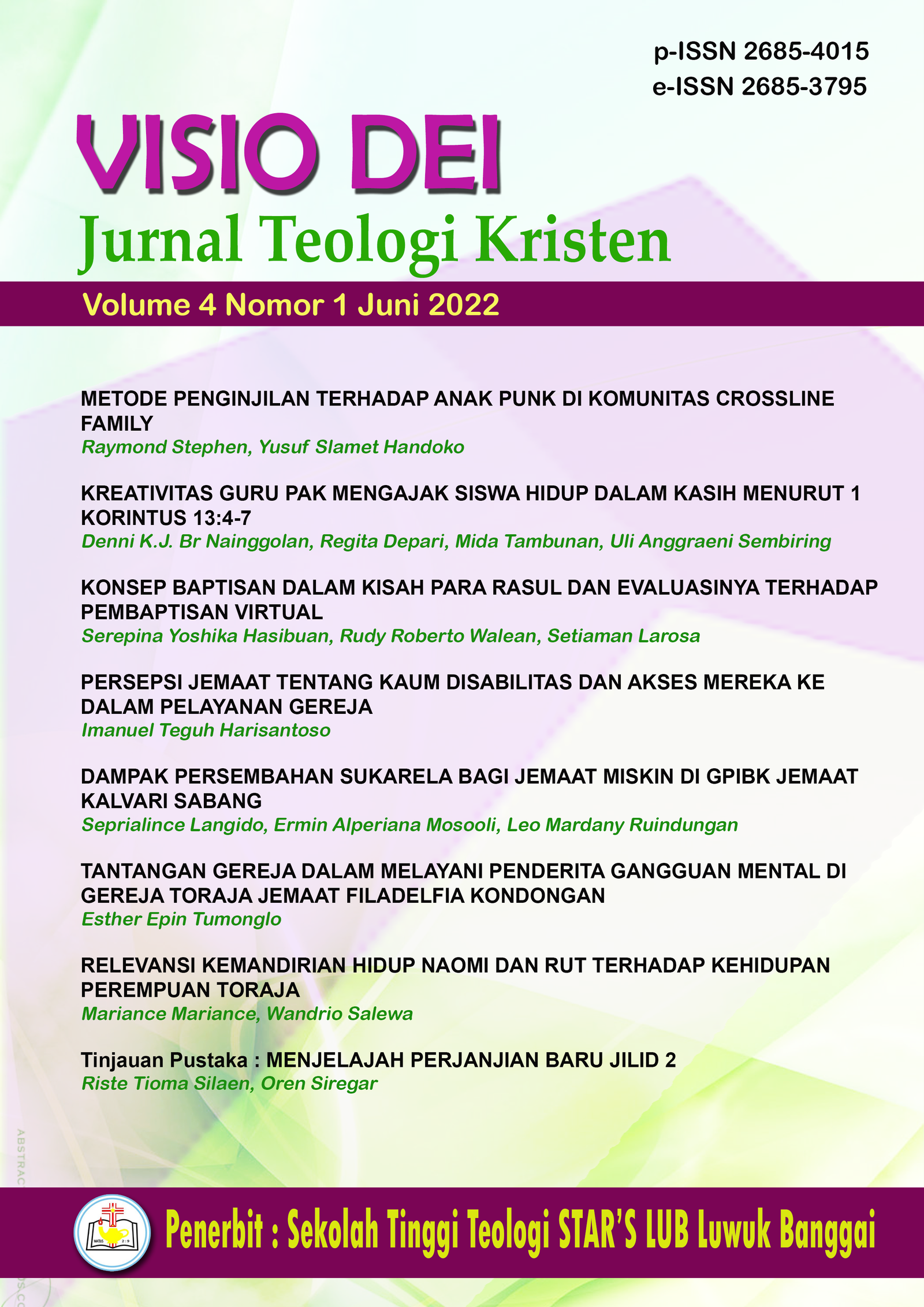THE IMPACT OF VOLUNTARY OFFERINGS TO THE POOR AT KALVARI SABANG CONGREGATION OF GPIBK
Abstract
Today some churches do not prescribe tithing but voluntary offerings. This study intends to conduct a study of churches that set voluntary offerings to find out: 1) whether the offerings given are lower or higher than one-tenth of income; 2) are the percentages the same for all levels in the church. The research subject is the Indonesian Protestant Church in Banggai Islands (GPIBK), one of the churches that do not apply tithing offerings. The research focuses on one of the largest congregations in GPIBK, the Kalvari Sabang Congregation, located in Sabang, North Bulagi sub-district, Banggai Islands district Central Sulawesi province. The method used is quantitative with a comparative study approach. A comparison of offerings is made based on social class, namely upper class, middle class, and lower class. The control variables are the total monthly income, the total monthly offerings to the church, and the percentage of the total monthly offerings to the church to the total monthly income. The unit of analysis is the family. The total number of families involved was 28 families. The study results are as follows: first, the Kalvari Sabang congregation gives offerings exceeding one-tenth of their income every month. The upper-class average is 12.52%, the middle class is 21.79%, and the lower class is 30.17%. Second, the percentage of offerings from the lower class is higher than that of the middle and upper classes. The lower the social class, the higher the percentage of giving to the church.
Downloads
References
Christiawan, A. F. (2018). Persepuluhan Menurut Maleakhi 3:7-12. Missio Ecclesiae, 7(1), 28–67. https://doi.org/10.52157/ME.V7I1.81
Darmaputera, E. (2001). Bisnis, Ekonomi, dan Penatalayan. BPK Gunung Mulia.
Epifani, Y. S. (2017). Pandangan Warga Jemaat di Pos Pelayanan dan Kesaksian (Pospelkes) Anugrah Sempuat Kalimantan Barat tentang Pelaksanaan Persepuluhan dan Bentuk-bentuk Persepuluhan [Universitas Kristen Satya Wacana]. https://repository.uksw.edu/handle/123456789/13441
Gea, I., & Gea, M. (2021). Makna Persembahan Persepuluhan Dan Relevansinya Pada Gereja Masa Kini. Areopagus : Jurnal Pendidikan Dan Teologi Kristen, 19(2), 78–90. https://doi.org/10.46965/JA.V19I2.700
Lintong, M., Mosooli, E. A., Ruindungan, L. M., & Lefran, L. (2021). Pendidikan Kewirausahaan Bagi Mahasiswa Program Studi Teologi STT Star’s Lub Untuk Kemandirian Finansial Gereja. VISIO DEI: Jurnal Teologi Kristen, 3(2), 217–237. https://doi.org/10.35909/VISIODEI.V3I2.240
Najoan, J. C. (2020). Akuntabilitas Persepuluhan Pada Gereja Kemah Injil Indonesia Jemaat Tamalanrea Makassar [Universitas Kristen Indonesia Paulus]. http://repository.akuntansiukipaulus.com/42/
Patterson, R. D. (1973). The Widow, the Orphan, and the Poor in the Old Testament and the Extra-Biblical Literature. Bibliotheca Sacra, 223–234.
PGI. (2020). Dokumen Keesaan Gereja Persekutuan Gereja-Gereja di Indonesia (DKG-PGI) 2019-2024. BPK Gunung Mulia.
Porajow, A. (2019). Motivasi Pemberian Persembahan dalam Kotak Kaca Kajian Teori Motivasi Abraham Maslow dan Teori Tindakan Sosial Max Weber di Jemaat GMIM Kanaan Pinabetengan [Fakultas Teologi Universitas Kristen Satya Wacana]. https://repository.uksw.edu/handle/123456789/18189?mode=full
Pranoto, D. S. (2014). Sikap Memberi Persembahan Menurut Injil Markus 12:41-44. Manna Rafflesia, 1(1), 17–35. https://doi.org/10.38091/MAN_RAF.V1I1.42
Sihar, O. I. J. L. (2013). Penatalayan dan Kemandirian Gereja (Suatu studi tentang peranan penatalayanan gereja di dalam usaha pencapaian kemandirian gereja dalam bidang dana di GPIB Kasih Karunia Medan) [Program Studi Teologi FTEO-UKSW]. https://repository.uksw.edu/handle/123456789/6879
Sitanggang, M. H. (2011). Teologi Biblika mengenai Perpuluhan. Veritas: Jurnal Teologi Dan Pelayanan, 12(1), 19–37. https://doi.org/10.36421/VERITAS.V12I1.240
Sugiyono. (2018). Metode Penelitian Kuantitatif, Kualitatif, dan R&D. Alfabeta.
Sukmawati. (2016). Akuntabilitas Gereja Dalam Perspektif Alkitabiah Dan Stewardship Theory (Study Kasus pada Gereja X di Jawa Timur). Jurnal Akuntansi Aktual, 3(4), 301–310. http://journal2.um.ac.id/index.php/jaa/article/view/7161
Wainarisi, Y. O. R. (2019). Menelaah Persoalan Kemiskinan Melalui Narasi Persembahan Janda Miskin (Markus 12:41-44). JURNAL LUXNOS, 5(1), 1–14. https://doi.org/10.47304/JL.V5I1.71
Walz, E. (2008). Bagaimana Mengelola Gereja Anda. BPK Gunung Mulia.
Wijaya, H. (2018). Khotbah Untuk Pendidikan Warga Jemaat. Sekolah Tinggi Theologia Jaffray.
Zega, Y. K. (2021). Pelayanan Diakonia: Upaya Gereja dalam Mengentaskan Kemiskinan bagi Warga Jemaat. IMMANUEL: Jurnal Teologi Dan Pendidikan Kristen, 2(2), 88–102. https://doi.org/10.46305/IM.V2I2.64
Copyright (c) 2022 Seprialince Langido, Ermin Alperiana Mosooli, Leo Mardany Ruindungan

This work is licensed under a Creative Commons Attribution-ShareAlike 4.0 International License.
Visio Dei: Jurnal Teologi Kristen publishes articles under the Creative Commons Attribution-ShareAlike 4.0 (CC BY-SA 4.0). Users are free to copy, modify, or redistribute articles for any lawful purpose in any media, provided they give appropriate credit to the original author and Visio Dei: Jurnal Teologi Kristen as the publisher, links to the license, indicate if changes have been made, and redistribute any derivative works under the same license.
Article copyright is held by the respective author (s), without limitation. A non-exclusive license is granted to Visio Dei: Jurnal Teologi Kristen to publish articles and identify itself as the original publisher, including commercial rights to sell them to libraries and individuals.
By publishing articles in Visio Dei: Jurnal Teologi Kristen, authors grant rights to third parties to use their articles to the extent granted by the Creative Commons Attribution-ShareAlike 4.0 International license.














